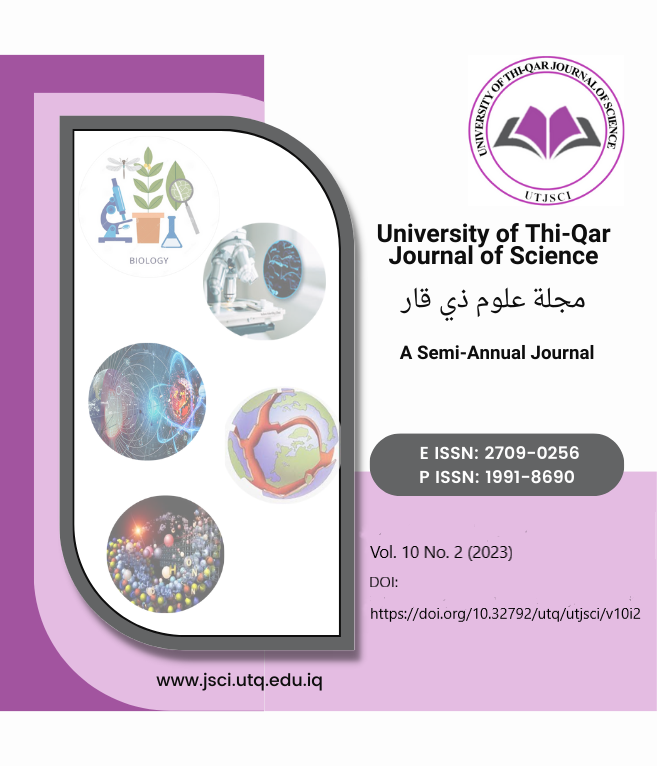Multi-Wall Carbon Nanotubes with NiO and pt as Counter Electrodes for DSSC applications
DOI:
https://doi.org/10.32792/utq/utjsci/v10i2.1124Keywords:
DSSCs, MWCNT, NiO, Platinum.Abstract
NiO-MWCNT was synthesized using the hydrothermal method and used as a low-cost, platinum-free counter electrode for Dye-sensitized solar cells DSSCs. The DSSC based on NiO-MWCNT as a counter electrode achieves a high-power conversion efficiency of 8.53% under a simulated solar illumination of 100 mW cm-2 (AM 1.5). This efficiency is comparable to 7.9% for a DSSC equipped with a Pt counter electrode. Good charge conduction characteristics of the NiO-MWCNT electrode decreases charge loss and boosts the effectiveness of converting light into electrical current. The NiO-MWCNT electrode also increases light absorption and increases the efficiency of converting light energy into electrical energy by enhancing light dispersion within the solar cell. Other advantages of NiO-MWCNT electrodes are low cost and great sustainability. Comparing it to platinum, rare and expensive material, the use of NiO-MWCNT reduces the cost of the solar cell and contributes to environmental sustainability. In addition, the NiO-MWCNT electrode has a high chemical stability, making it more resistant to corrosion and damage in dye solar cell environments. This enhances the lifespan of the cell and ensures its long-term sustainability.
Received: 2023-10-08
Revised: 2023-10-20
Accepted: 2023-10-22
References
A. Hirsch, “The era of carbon allotropes,” Nat. Mater., vol. 9, no. 11, pp. 868–871, 2010.
R.-S. Zhang and J.-W. Jiang, “The art of designing carbon allotropes,” Front. Phys., vol. 14, no. 1, p. 13401, 2019.
Q. Luo et al., “All?carbon?electrode?based endurable flexible perovskite solar cells,” Adv. Funct. Mater., vol. 28, no. 11, p. 1706777, 2018.
Y. Zhang et al., “Flexible and stretchable lithium?ion batteries and supercapacitors based on electrically conducting carbon nanotube fiber springs,” Angew. Chemie Int. Ed., vol. 53, no. 52, pp. 14564–14568, 2014.
T. Ye et al., “Pinhole-free mixed perovskite film for bending durable mixed perovskite solar cells,” Sol. Energy Mater. Sol. Cells, vol. 175, pp. 111–117, 2018.
Z. Zhang, L. Wei, X. Qin, and Y. Li, “Carbon nanomaterials for photovoltaic process,” Nano Energy, vol. 15, pp. 490–522, 2015.
T. Saga, “Crystalline and Polycrystalline Silicon PV Technology,” NPG Asia mater, vol. 2, no. 3, pp. 96–102, 2010.
B. O. Reagen and M. Gratzel, “A Low-Cost, High-Efficiency Solar Cell Based on Dye-Sensitized Colloidal Ti0 (2) Films,” Nature, vol. 353, no. 6346, p. 737, 1991.
D. Anghel, A. Lascu, I. Fratilescu, C. Epuran, N. Plesu, and E. F?g?dar-Cosma, “Review about Main Requirements for Porphyrin Derivatives as Components of Dye Sensitized Solar Cells,” J. Sol. Energy Res. Updat., vol. 6, pp. 78–86, 2019.
E. Olsen, G. Hagen, and S. E. Lindquist, “Dissolution of platinum in methoxy propionitrile containing LiI/I2,” Sol. Energy Mater. Sol. Cells, vol. 63, no. 3, pp. 267–273, 2000.
T. Hino, Y. Ogawa, and N. Kuramoto, “Preparation of functionalized and non-functionalized fullerene thin films on ITO glasses and the application to a counter electrode in a dye-sensitized solar cell,” Carbon N. Y., vol. 44, no. 5, pp. 880–887, 2006.
H. Choi, H. Kim, S. Hwang, W. Choi, and M. Jeon, “Dye-sensitized solar cells using graphene-based carbon nano composite as counter electrode,” Sol. Energy Mater. Sol. Cells, vol. 95, no. 1, pp. 323–325, 2011.
J. M. Nugent, K. S. V Santhanam, a A. Rubio, and P. M. Ajayan, “Fast electron transfer kinetics on multiwalled carbon nanotube microbundle electrodes,” Nano Lett., vol. 1, no. 2, pp. 87–91, 2001.
Downloads
Published
License
Copyright (c) 2023 University of Thi-Qar Journal of Science

This work is licensed under a Creative Commons Attribution 4.0 International License.













